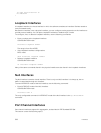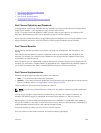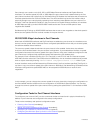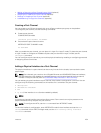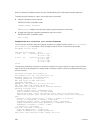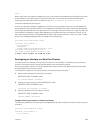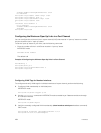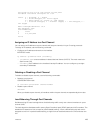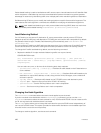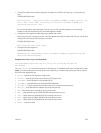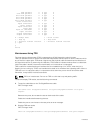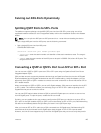
Packet based hashing is used to load balance traffic across a port-channel based on the IP Identifier field
within the packet. Load balancing uses source and destination packet information to get the greatest
advantage of resources by distributing traffic over multiple paths when transferring data to a destination.
Dell Networking OS allows you to modify the hashing algorithms used for flows and for fragments. The
load-balance and hash-algorithm commands are available for modifying the distribution algorithms.
NOTE: Hash-based load-balancing on multi-protocol label switching (MPLS) does not work when
you enable packet-based hashing (load-balance ip-selection packet-based).
Load-Balancing Method
For LAG hashing on the source IP, destination IP, source transmission control protocol (TCP)/user
datagram protocol (UDP) port, and destination TCP/UDP port are used for hash computation by default.
For packets without a Layer 3 header, Dell Networking OS automatically uses load-balance mac
source-dest-mac.
Do not configure IP hashing or MAC hashing at the same time. If you configure an IP and MAC hashing
scheme at the same time, the MAC hashing scheme takes precedence over the IP hashing scheme.
To change the IP traffic load-balancing default, use the following command.
• Replace the default IP 4-tuple method of balancing traffic over a port channel.
CONFIGURATION mode
[no] load-balance {ip-selection [dest-ip | source-ip]} | {mac [dest-mac |
source-dest-mac | source-mac]} | {tcp-udp enable} {ipv6-selection} {tunnel}|
{ingress-port}
You can select one, two, or all three of the following basic hash methods:
– ip-selection [dest-ip | source-ip] — Distribute IP traffic based on the IP destination or
source address.
– mac [dest-mac | source-dest-mac | source-mac] — Distribute IPV4 traffic based on the
destination or source MAC address, or both, along with the VLAN, Ethertype, source module ID
and source port ID.
– tcp-udp enable — Distribute traffic based on the TCP/UDP source and destination ports.
– ingress-port — Option to Source Port Id for ECMP/ LAG hashing.
– ipv6-selection— Set the IPV6 key fields to use in hash computation.
– tunnel— Set the tunnel key fields to use in hash computation.
Changing the Hash Algorithm
The load-balance command selects the hash criteria applied to port channels.
If you do not obtain even distribution with the load-balance command, you can use the hash-
algorithm command to select the hash scheme for LAG, ECMP and NH-ECMP. You can rotate or shift
the 12–bit Lag Hash until the desired hash is achieved.
The nh-ecmp option allows you to change the hash value for recursive ECMP routes independently of
non-recursive ECMP routes. This option provides for better traffic distribution over available equal cost
links that involve a recursive next hop lookup.
To change to another algorithm, use the second command.
406
Interfaces



